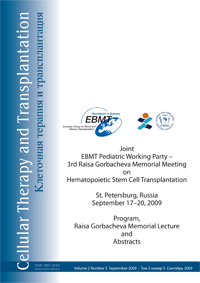Genetic polymorphisms of CYP1A1, GSTM1, GSTT1, and GSTP1 genes in В-cellular chronic lymphocytic leukemia (B-CLL)
Vanik A. Ovsepyan, Vitaliy A. Rosin
Federal State Institution, Kirov Hematology and Blood Transfusion Research Institute under Federal Medicobiological Agency, Kirov, Russia
Summary
Aim
The aim of this study was to examine the relationship between genetic polymorphisms in GSTM1, GSTT1, GSTP1, and CYP1A1 genes and their susceptibility to B–CLL.
Methods
The DNA for our research was isolated from the leukocytes of venous peripheral blood taken from 146 patients with B-cell CLL and 221 healthy individuals, using a standard phenol-chloroform extraction method. GSTM1 and GSTT1 genotypes were determined by a multiplex PCR technique that detects homozygous deletions of the mentioned genes and the β-globin housekeeping gene as an internal control. CYP1A1 mutation A4889G (Ile462Val) and GSTP1 polymorphisms A1578G (Ile105Val) and T2293C (Аla114Val) were identified by the PCR-RFLP approach.
Results
For the first time it was shown that the mutant genotype (GSTP1-105IleVal+GSTP1-105ValVal) occurs significantly more often in B-CLL patients than that of healthy individuals (65.1% ps. 53.4%, χ2 = 4.92, p<0.05; OR=1.63, 95% CI=1.06÷2.50), whereas the "wild" genotype GSTP1-105IleIle was significantly underrepresented in patients with CLL compared with those of healthy individuals (34.9% ps. 46.6%, χ2 = 4.92, p<0.05; OR=0.62, 95% CI=0.40÷0.95).
At the same time the difference in distribution of homozygous deletion of the GSTM1 and GSTT1 genes and also of the CYP1A1-Ile462Val and GSTP1-Ala114Val genotypes between B-CLL patients and healthy individuals was statistically not significant (p>0.05).
Conclusions
The results of the current study suggested that the GSTP1 polymorphism may influence the risk of B-CLL developing.
Keywords
B-CLL, genetic susceptibility, CYP1A1 polymorphism, GSTM1 polymorphism, GSTT1 polymorphism, GSTP1 polymorphism


